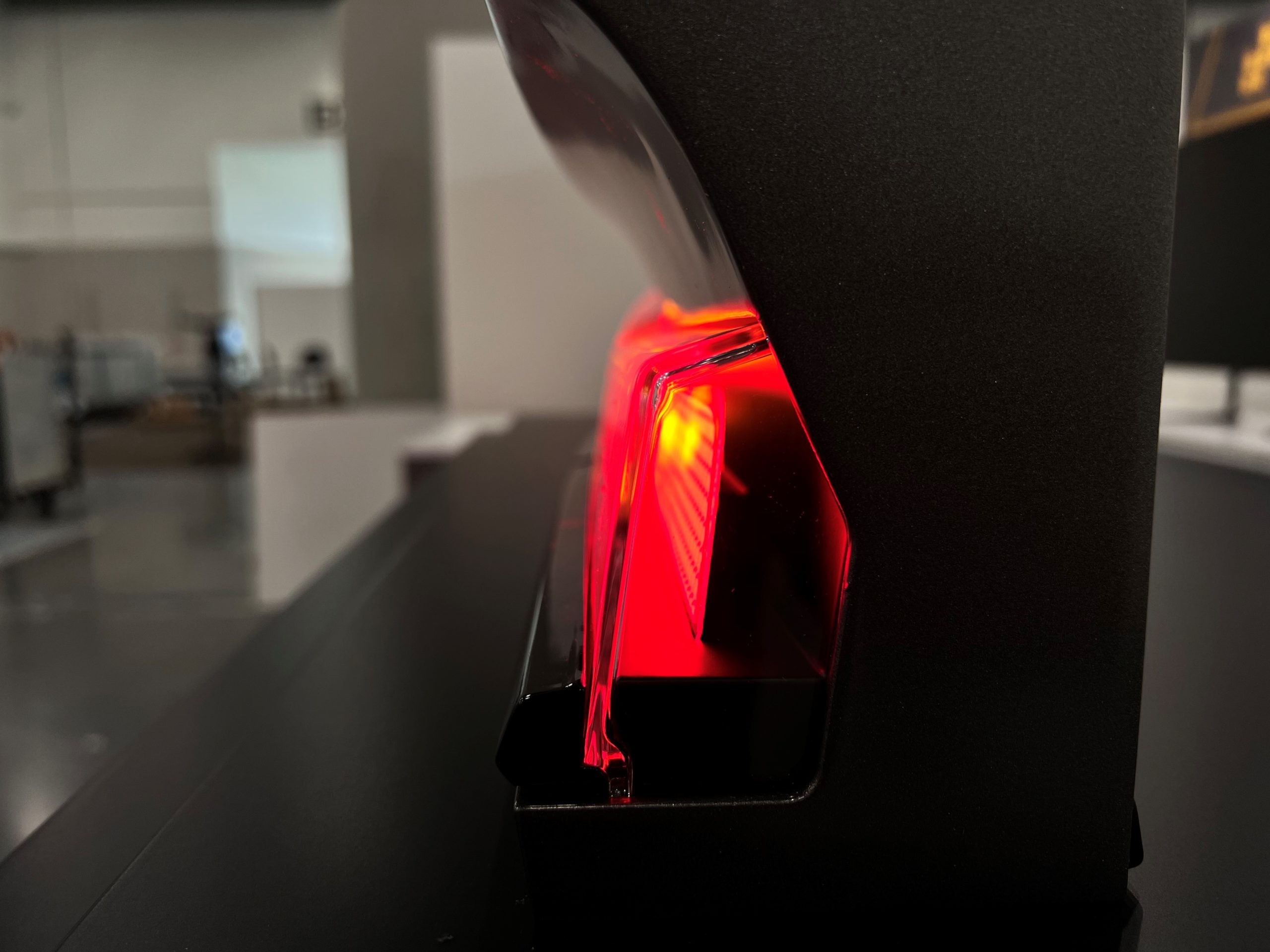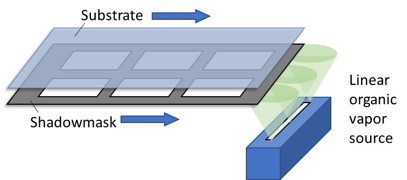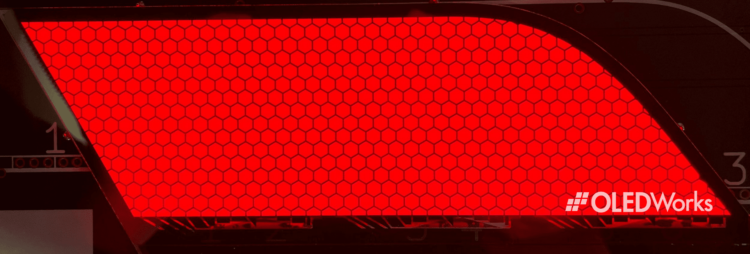
This transcript is part of a panel on diffuse lighting at the 2022 DOE Solid-State Lighting Workshop, featuring Jeff Spindler, Director of Research & Development at OLEDWorks. Watch the full presentation recording here: Diffuse Lighting Panels.
OLED Strengths
Naturally Diffuse Lighting in an Ultra-Thin Package
Some of the strengths of OLEDs, and really what differentiates them from other technologies, is their naturally diffuse behavior. They are surface area emitters by nature, so as uniformly as you can inject and spread current through the electrode, you’ll get very uniform emission of light over the whole surface.
OLEDs have a very thin package. The active layers we coat are typically less than a micron, so the whole thickness of the panel is determined by the substrate thickness and any films we might add. In the picture below, you can see a very thin panel, very beautiful, uniformly diffuse light, with a Lambertian distribution by nature.
If you want point sources or spotlights, highly directional light, you’re better off using LEDs. But where you want a diffuse, beautiful, homogenous light that’s good to look at, OLEDs are perfect for those applications.

Ultra-thin profile of automotive OLED lighting technology
High Brightness with Multi-Stack Design
We’ve found that OLEDs can be easily stacked, meaning, we can make multiple units or multiple “stacks” of OLED units that build on each other vertically, which increases the voltage but also increases the amount of light emitted proportionally to the number of stacks. So, we can use that trick to produce much higher brightness out of the same panel.
We can do that for instance in red OLEDs for taillights and automotive use. If we want 1,000 or 2,000 nits, we use 1 or 2 stacks. If you want 20,000 nits or more, you can use 6 or more stacks and produce very high brightness in the same panel.
You can do this with any color. We make very high brightness white OLEDs by multi-stack blue and yellow emission stacks. Yellow is a combination of red and green emitters. You can tune the color temperature by changing the ratio of yellow and blue, and the applications are unlimited – we can make any color or combination of colors. It’s a highly flexible technology with an unlimited number of organic compounds.
OLEDs are Affordable, Sustainable, and Segmentable
One thing I think is often overlooked in cost is that OLEDs can provide the opportunity to reduce your integrated system costs. If you’re just looking at upfront dollar per lumen or upfront panel costs, you might decide that OLEDs are too expensive. But there are fewer components with OLEDs than typical LED systems or other optical systems.
OLEDs are also very sustainable. The panel is mostly glass, and there aren’t bulky heatsinks and things that you need to dispose of in the future, so they’re good for sustainability among other benefits.
Another attractive differentiator with OLEDs is segmentation. It’s almost like a low-resolution display with large emitting segments that can be individually addressed and turned on and off. Each segment can be extremely uniform, with 90% or better uniformity within that segment, and very high contrast — very black when it’s off. That’s why OLEDs are very good in displays, because you can create 3D effects and really cool digital effects.
OLED Opportunities
- Education: It’s surprising how many people don’t know much, or anything, about OLEDs, so we continue our education efforts and appreciate the DOE’s support there.
- Get the light out: The best products still trap about half the light, so we can still improve on efficiency.
- Get the cost out: Larger volume segments have already gotten the cost out. It’s really a volume thing and improving manufacturing processes and increasing throughput will help reduce costs.
OLED Technology Trends
We should look briefly at some trends because OLEDs have been around for a while — displays for over 20 years. In the case of mobile smartphones, there is a really large penetration of OLEDs closing in on 50% of that application.
With other larger displays like TVs and monitors, it’s newer and there is slower adoption. But OLEDs are growing in all these display segments including microdisplays and automotive interior displays. Many of the trends there are toward flexibility, high-resolution, high brightness, high contrast, and dynamic range.
In lighting applications, both general and automotive, we’re also seeing the same trends toward flexibility, high brightness, segmentation, and a combination of those things. With automotive applications, you’re going to see a combination of flexibility and segmentation with high brightness, so you can curve around the curved features of automobiles or other vehicles.
OLED Applications – Automotive Lighting
As a company we see this as our largest growth segment for the next several years as there’s a lot of demand for these kinds of applications. In the last few weeks at the CES Show, we demonstrated an all-OLED rear combination lamp, basically an integrated fixture with multiple red OLED custom-shaped panels with a high amount of segmentation and amber turn signals. It’s a beautiful demonstrator with over 2,000-2,500 individually addressable segments.

Latest automotive OLED lighting panel presented at CES with over 600 segments. Lit dimensions 56mm x 203mm
Other automotive applications that people are interested in:
-
- Center High Mounted Stop Lights (CHMSL)
- Turn signals
- Dome lighting
- Mirrored lighting
- Branded signatures and emblems
Presently, we offer a deep red panel with a few segments, but we are working on panels with higher brightness, more colors (amber & white), bendable and rigid profiles, and many more segments per panel.
How are OLED Panels Made?
So, how do we make OLEDs? It’s basically done in a display-like process right now using large vacuum chambers and vacuum thermal evaporation, or VTE. We have linear organic sources where we distribute a vapor that is created from heating organic compounds. It’s basically a sublimation and condensation process, where the vapor deposits on the glass as it passes by and gets patterned through a shadowmask.
This process works well and is scaled up in the display market. But there are still some challenges, like achieving higher throughput. You can speed the process up, and you do that by generally just heating the materials more. We’ve also found that some organic compounds degrade sooner than others. It’s really a case-by-case basis, but we’re always trying to push those limits. I think the material makers have realized that they need to create good organic compounds that have good thermal stability, but there’s still some room for improvement there.
We sometimes make multi-component layers that could have 3 or 4 sources on at the same time, where perfect uniformity can be a challenge.
Once you’ve designed your inline system, you need to design it for flexibility. If you want to add a layer here or there, you need to consider that upfront as it’s hard to change your source configurations after the fact.
Shadowmask: A thin sheet of metal with pre-defined openings that determines where the organic material is deposited on the glass substrate by blocking deposition everywhere else. The standard method for patterning OLED organic and cathode layers.
Shadowmasks are a component we typically use that requires regular cleaning. If you’re going to do a roll-to-roll type process, that would be very difficult with a shadowmask. We did successfully demonstrate one non-mask-patterning process using a UV laser through a window, so the laser is outside the vacuum, and we demonstrated that we can pattern organics and successfully make OLEDs using that approach.
Other techniques not quite proven that have been worked on for a long time include inkjet printing, which I don’t think is compatible with these highly multi-stack OLEDs, so you might be limited to single-stack OLED formulations. Other vapor printing techniques are under development and need to be proven. And roll-to-roll OLED manufacturing in general is not really proven. There’s only been one large-scale industrial effort in Japan which has mostly failed.
Flexible OLEDs
Flexible OLEDs are currently made a lot like we make rigid OLEDs. With our partners like Corning, we basically bond the thin glass to a rigid glass carrier and that can be processed just like a rigid piece through your existing rigid glass equipment. This does require additional processing (bonding and de-bonding in the end), and some edge treatment on the final cut panels to increase their bend strength.
If you’re going to make flexible panels, I think that really opens the opportunity for roll-to-roll manufacturing where the whole panel can be produced in a roll-to-roll manner and could potentially lower costs than the sheet processing technique.
You could make the substrate for instance roll-to-roll and then go to a sheet process or do the whole thing roll-to-roll. There are some development efforts in Europe and Asia to do roll-to-roll OLED deposition, but this has not really developed well yet — it has only been demonstrated. There are a number of needs for material handling, patterning, robust encapsulation technology, and backend processing. How do you handle all these individual parts with high yield?
Key Priorities for R&D
Here are a few of the key priorities we think are needed to improve OLED manufacturing, produce higher volumes, and lower costs:
- Working on technologies compatible with roll-to-roll processing
- Encapsulation technology that lowers costs and higher throughput, for instance an all-vacuum process
- Continue working on light extraction to get more of the light out – this could help reduce costs and improve the product performance
- Flexible OLEDs – there is some added cost with some of the components and processing, we need to reduce the cost and have robust electrical, mechanical, and thermal connections
- Segmented OLEDs – Again, there’s some additional cost components like FPC’s, so we need to bring the cost out of that kind of product.
In general, OLEDs could be considered more for complimentary studies with LEDs to achieve overall lighting goals for energy efficiency, health, wellness, and other benefits. There is a lot of talk about lighting application efficiency, and OLEDs are an ideal light source for where you need to bring the light source close to the user, see the light, and put the light where you want. I think OLEDs get overlooked a lot, and we can do a better job there.
We should consider more work on hybrid systems, including integrated drivers, power delivery, and look for synergies in segmentation, tunability, and other features.
___
Additional Reading from the Department of Energy
DOE Publishes 2022 Solid-State Lighting R&D Opportunities





